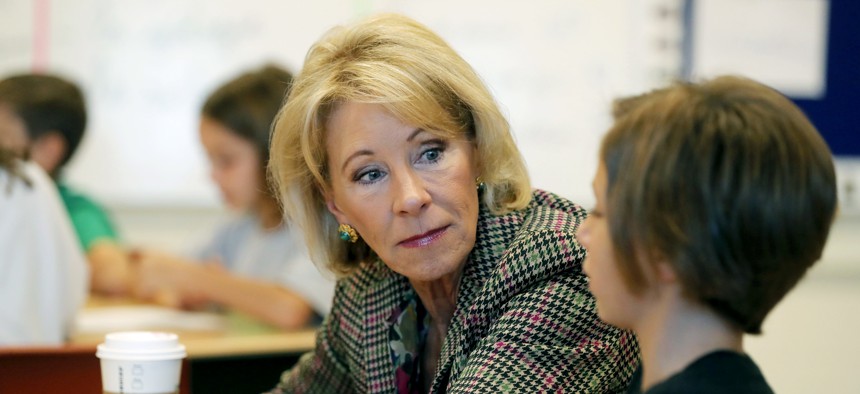Trump’s School-Safety Commission’s Strange Focus on Discipline

Education Secretary Betsy DeVos visits a classroom at the Edward Hynes Charter School in New Orleans, Friday, Oct. 5, 2018. AP Photo/Gerald Herbert
The administration wants to keep schools safe by ditching rules meant to prevent racial bias in school discipline.
On Tuesday, President Donald Trump’s school-safety commission, which was established following the school shooting in Parkland, Florida, released its much-anticipated recommendations “to advance safety” in schools, including one that would scrap a federal policy urging schools not to punish minority students at a higher rate than white students.
The commission’s recommendation to roll back the Obama administration’s school-discipline guidance does not come as a surprise. Republicans have decried the policy as government overreach since it was released in 2014. The policy advocated “constructive approaches” to school discipline, such as victim-offender mediation, as opposed to harsher penalties such as suspensions or expulsions.
The Trump administration’s discipline recommendation comes alongside several bipartisan common-sense measures in the report, including encouraging teachers, administrators, and parents to be vigilant about reporting information to the FBI; improving access to school mental-health services and counseling; and implementing best practices to curb cyberbullying. The report also advocates that districts create a “media plan” to disseminate information in the event of a shooting, alongside a suggestion to follow “No Notoriety” guidelines to keep the focus in the aftermath of an incident on the victims rather than on the shooter.
The school-safety commission’s recommendations are just that: recommendations. As the report notes, “Implementation of the practices identified in this guide is purely voluntary, and no federal agency will take any action against schools that do not adopt them.” School districts have been slow to respond to such nonbinding recommendations in the past—including school-safety recommendations in the wake of school shootings during both the George W. Bush and Barack Obama administrations.
Given the broad mandate of developing recommendations to address school violence, the administration took to addressing the school-discipline guidelines remarkably quickly. The commission argues that the guidance left schools unable—or at least afraid to—take action against potentially dangerous students. “Policy guidance issued under the Obama Administration placed an emphasis on tracking school disciplinary actions by race,” the report says. “The Guidance sent the unfortunate message that the federal government, rather than teachers and local administrators, best handles school discipline.” The commission argued that the emphasis on avoiding a disparity in which students are disciplined may lead school leaders to let their school-discipline policies be driven by numbers, rather than by teacher input.
Education Secretary Betsy DeVos, who chairs the commission, argued that a one-size-fits-all approach to school safety would not work. “Through the Commission’s work, it has become even clearer there is no single policy that will make our schools safer,” she said in a statement. “What will work for schools in Montana will be different than what will work for schools in Manhattan.”
Still, the administration’s focus on school discipline has been highly contested—primarily because it seems disconnected from the broader issue of preventing the next school shooting. “It is unconscionable to use the very real horror of the shooting at Parkland to advance a preexisting agenda that encourages the criminalization of children and undermines their civil rights,” Vanita Gupta, the president of the Leadership Conference on Civil and Human Rights, said in a statement following the report’s release. Gupta’s statement tracks with months of criticism of the proposal to scrap the school-discipline guidance. Supporters of the Obama guidance argue that it is necessary to counteract the effects of the inequitable doling out of discipline.
Both Obama-era education secretaries, Arne Duncan and John B. King Jr., released a joint statement on the committee’s recommendation on Tuesday. “We put this guidance in place to start a conversation about these harmful practices and encourage advocates and policymakers to look more deeply into why these disparities exist and to intervene when necessary,” they said. In April, the Department of Education released its annual Civil Rights Data Collection report, which showed that black students made up 15 percent of K–12 enrollments nationwide, but 31 percent of expulsions.
Bobby Scott, the top Democrat on the U.S. House Committee on Education and the Workforce—who will become the committee chair next year—put the sentiment of those who prefer to keep the guidance plainly. “Rather than confronting the role of guns in gun violence, the Trump administration blames school shootings on civil rights enforcement,” he said in a statement. “This guidance has no connection to school shootings.”
While advocates and experts of all political stripes are likely to agree with several of the recommendations of the report, the recommendation on school discipline delves, perhaps unnecessarily, into one of the most politically contentious issues in education. As my colleague Alia Wong wrote in March, “For Washington policymakers to give outsized attention to student-discipline reform is to succumb to ideological precepts that lack empirical support. It is to waste the lessons gleaned from the growing tally of school shootings while reinforcing racial disparities.”
Adam Harris is a staff writer at The Atlantic, which originally published this article.
NEXT STORY: New Survey Finds Big Increase in U.S. Teen Vaping





